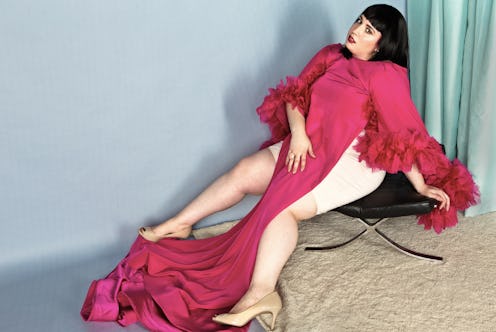Fashion
This New Editorial Tackles Sample Sizing

Working in fashion as a plus size woman can be difficult: Not only because fashion is a difficult industry, but because of the sizeism that is prevalent in society at large. For these reasons, Refinery29 writer and plus size blogger Liz Black's "What Is Sample Size?" editorial for intersectional media platform You Do You is calling out sample sizes in the industry. Along the way, she is illustrating the problem with only producing clothing in the smallest sizes possible, while representing the day to day issues so many plus size women — and even women slightly larger than what is considered "average" at a size 12/14 — deal with on the daily.
The shoot takes on the weight and body prejudices evident in sample sizing at full-throttle. In collaboration with You Do You, Black put (or attempted to put) her size 14 body in sample sizes from brands across the industry. The contrast between her "average" American body and the fashion world's sizing norm is unsettling, leaving us to ask: Who are the people meant to buy these clothes? After all, the majority of the American market simply isn't represented by sample sizes in 0 or 00.
Black's struggle to fit into these garments is representative of both an industry that's seemingly unwilling to change and the women who are taught to feel shame for not fitting into the mold. The images are striking, and serve as proof that the problem isn't plus size bodies — or, specifically, plus size women. The problem is an exclusionary sizing system.
Whether we're talking fast fashion or high end goods, being surrounded by clothes that don't fit you can be emotionally taxing. From my personal experiences working in retail, knowing that I didn't fit into the clothing around me made me feel like a fraud — even though my passion for the world of style was more pronounced than it is for many. To only be able to make, or be surround by, clothing in sizes 0 or 00 at a size 14 or above must be harder still.
Such a person would be forced to see and feel the clothing size that the world considers "ideal" constantly, only to compare it against their own frame — a frame that doesn't look like that, has never looked like that, and will probably never look like that.
Outside of the fashion industry, such contrasts still remain. As You Do You pointed out in the article accompanying the shoot, 67 percent of U.S. women wear a size 14 or larger. While the plus size fashion industry is seemingly trying to make its way into the mainstream, the primary representation we see for ourselves in fashion is of tall, thin, often white, and always exceptionally beautiful women.
This has been the standard for a long time. But thankfully, albeit slowly, the world can hopefully start to see things a little differently through shoots like these. At the very least, women sizes 14 or larger can see themselves represented in ways they never have been previously.
I spoke to Black, the creator and model of this project, via email about her personal relationship with fashion, body positivity, and why fashion needs to embrace body positivity to its full extent — rather than as a tagline on Instagram campaigns alone.
When asked what she wants to see from the sartorial world in the future, her answer left nothing and nobody out: "Greater representation for a variety of body types, ages, ethnicities, and abilities. I am personally focusing on size inclusivity as I have been covering plus size fashion for more than five years now, and it is a subject that is clearly dear to me."
She adds that "people of ALL different sizes struggle with body image, and seeing homogeneous runways and campaigns [is] not helping anyone, but diversity does help. The 'exclusive' fashion industry is an antiquated concept; the future is in inclusion."
Black's body positivity focuses on "everyone, not just those above a certain size. It's the embracing of our own bodies, 'imperfections' and all, and accepting that we are how we are." This shoot, however, seems to pointedly call out an industry that often alienates those over a certain size. As both a consumer and a writer, Black notes that she sees the negative effects of sample sizes daily.
"We're seeing the effects on a fairly frequent basis — Leslie Jones, Dascha Polanco, Melissa McCarthy, and many other non-sample size celebs have been very vocal about their issues finding designers to fit them. By having only one size available in their samples, designers are completely unable to dress any woman above a very tiny size, limiting them to who they can work with."
She continues, "Even past that, the effects are felt. One size sample sizes force homogeneous runways, which lack inclusivity and representation. Representation is so important, and a variety of body types deserve to be represented in all levels of fashion — from couture runways to mass marketers."
What Black says undoubtedly makes sense: Whether size M, 6X, or anything and everything in between and beyond, most sizes are not seen in fashion weeks, mainstream magazines, or in fashion houses' standardized sizing. The exclusion is felt by most of us, when, as Black says, everyone deserves to be represented and catered to through style.
Images: Courtesy Photographer Kristiina Wilson, Stylist Rachel Donelan, HMU Michael Chua, Model Liz Black